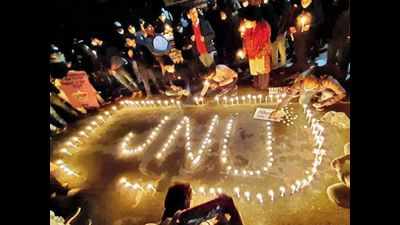- News
- City News
- delhi News
- JNU human chain marks a year of violence
Trending
This story is from January 6, 2021
JNU human chain marks a year of violence
A year after masked intruders ran amok in Jawaharlal Nehru University, students and teachers retraced the spots that were under attack on January 5 last year. In their peace vigil on Tuesday, students and teachers stood in a human chain that started from the Sabarmati T-point to the North Gate of the university campus, from where the as yet unapprehended rioters were said to have entered the campus a year ago.

The protest culminated in the students and the JNUTA members lighting candles and placing them in formation to spell JNU
NEW DELHI: A year after masked intruders ran amok in Jawaharlal Nehru University, students and teachers retraced the spots that were under attack on January 5 last year. In their peace vigil on Tuesday, students and teachers stood in a human chain that started from the Sabarmati T-point to the North Gate of the university campus, from where the as yet unapprehended rioters were said to have entered the campus a year ago.
“It was like any other afternoon in JNU campus. The JNUTA was organising a peace March at Sabarmati Dhaba and common students of the campus also joined in large numbers,” recalled N Sai Balaji, AISA head and former JNU Students’ Union president. “But as the afternoon stretched to evening, things changed horrifically. We saw the brutal attacks on JNU students and teachers by a group of masked men and women armed with sticks, iron rods and sledgehammers. We saw the bloodied faces of the university students’ union president and general secretary. We saw one of our beloved faculty members from Centre for the Study of Regional Development grievously injured and we saw hostels after hostels being attacked by the masked goons.”
On Tuesday, JNUSU vice-president Saket Moon said, “We are on this peace vigil to raise our voice for justice because there is an attempt being made to make people forget the incident that shook the campus a year ago. We want those who wore masks and attacked us to be brought to account.” Moushumi Basu, secretary, JNU Teachers’ Association, added, “We do not want people to forget what happened that day. And we came back to the spot of the attack to show the assailants that you cannot wipe us out.”
Addressing the gathering, JNUSU president Aishe Ghosh declared that the fight was for an “alternative idea of JNU” that was socially inclusive and gender-inclusive. “We may be beaten and attacked for this, but we will continue to fight and protect that JNU. Our university culture is of debate and dissent. These are enunciated in dhabas discussions and through pamphlets. Today, we perceive an attempt to shut down these very dhabas on the campus.”
“It was like any other afternoon in JNU campus. The JNUTA was organising a peace March at Sabarmati Dhaba and common students of the campus also joined in large numbers,” recalled N Sai Balaji, AISA head and former JNU Students’ Union president. “But as the afternoon stretched to evening, things changed horrifically. We saw the brutal attacks on JNU students and teachers by a group of masked men and women armed with sticks, iron rods and sledgehammers. We saw the bloodied faces of the university students’ union president and general secretary. We saw one of our beloved faculty members from Centre for the Study of Regional Development grievously injured and we saw hostels after hostels being attacked by the masked goons.”
On Tuesday, JNUSU vice-president Saket Moon said, “We are on this peace vigil to raise our voice for justice because there is an attempt being made to make people forget the incident that shook the campus a year ago. We want those who wore masks and attacked us to be brought to account.” Moushumi Basu, secretary, JNU Teachers’ Association, added, “We do not want people to forget what happened that day. And we came back to the spot of the attack to show the assailants that you cannot wipe us out.”
Addressing the gathering, JNUSU president Aishe Ghosh declared that the fight was for an “alternative idea of JNU” that was socially inclusive and gender-inclusive. “We may be beaten and attacked for this, but we will continue to fight and protect that JNU. Our university culture is of debate and dissent. These are enunciated in dhabas discussions and through pamphlets. Today, we perceive an attempt to shut down these very dhabas on the campus.”
The protest culminated in the students and the JNUTA members lighting candles and placing them in formation to spell JNU. Earlier in the day, the RSS-affiliated ABVP conducted its own remembrance march against ‘red terror’ on the campus. “A padayatra from Sabarmati dhaba to JNU main gate was held to condemn the hooliganism of Left Unity,” said Shivam Chaurasia, president of ABVP’s JNU unit. “Several organisations such as JNUTF, YUVA, Vivekananda Vichar Manch and Ambedkar Vichar Manch also participated in the padyatra to show their dissent against the Left-sponsored violence in universities.”
End of Article
FOLLOW US ON SOCIAL MEDIA










